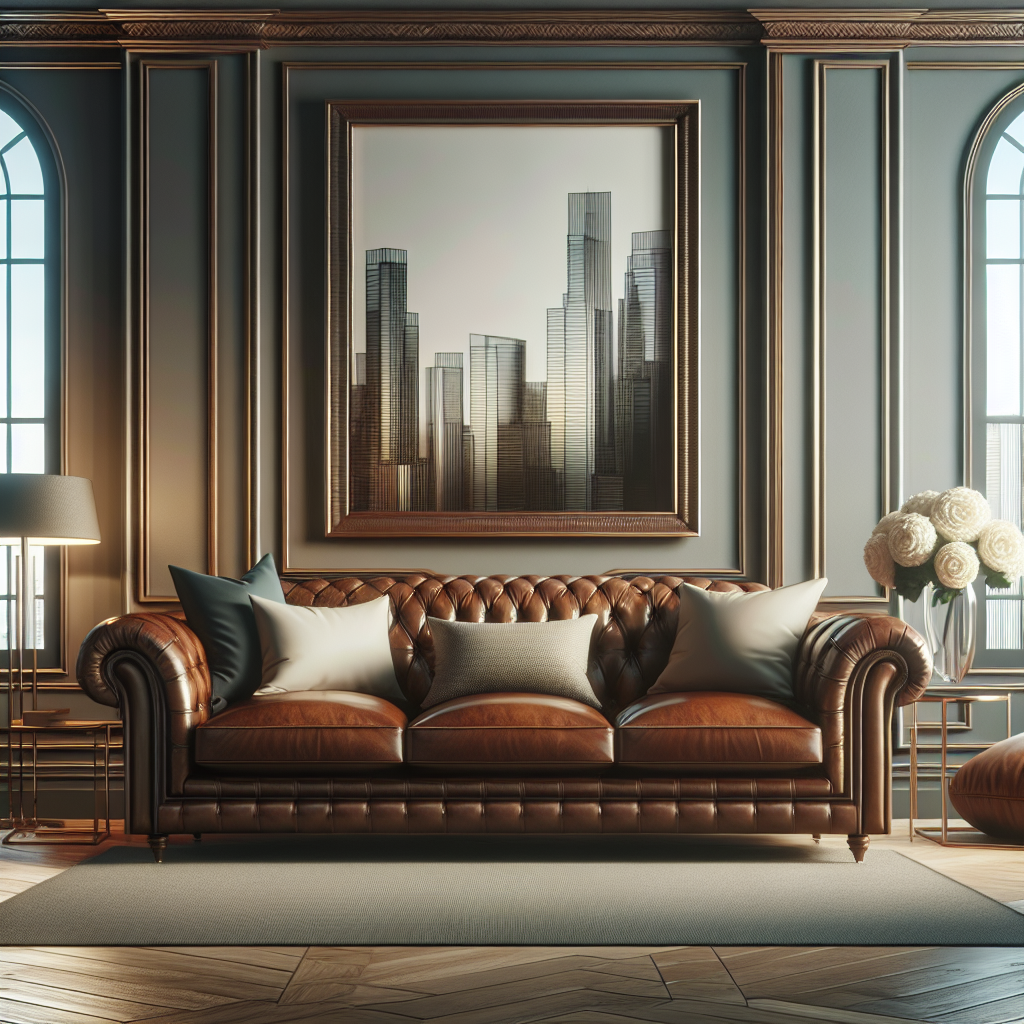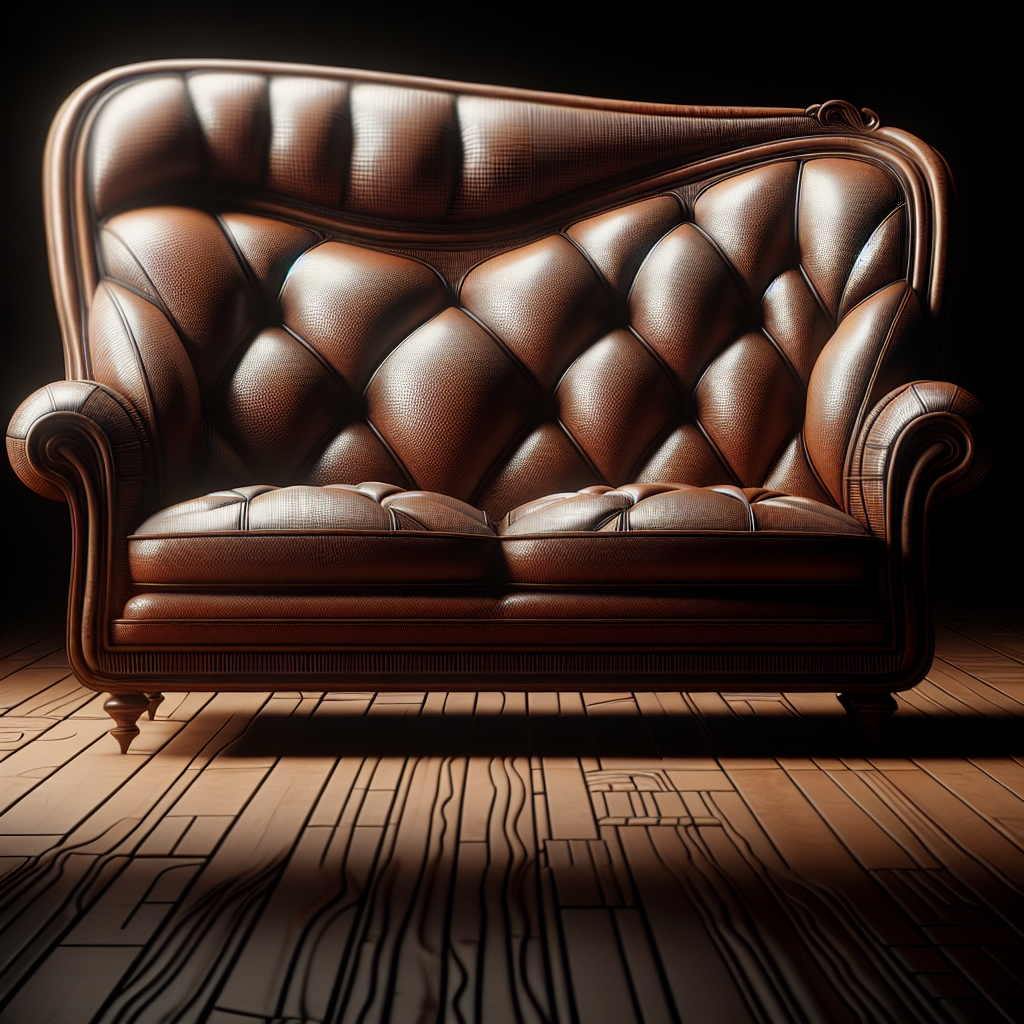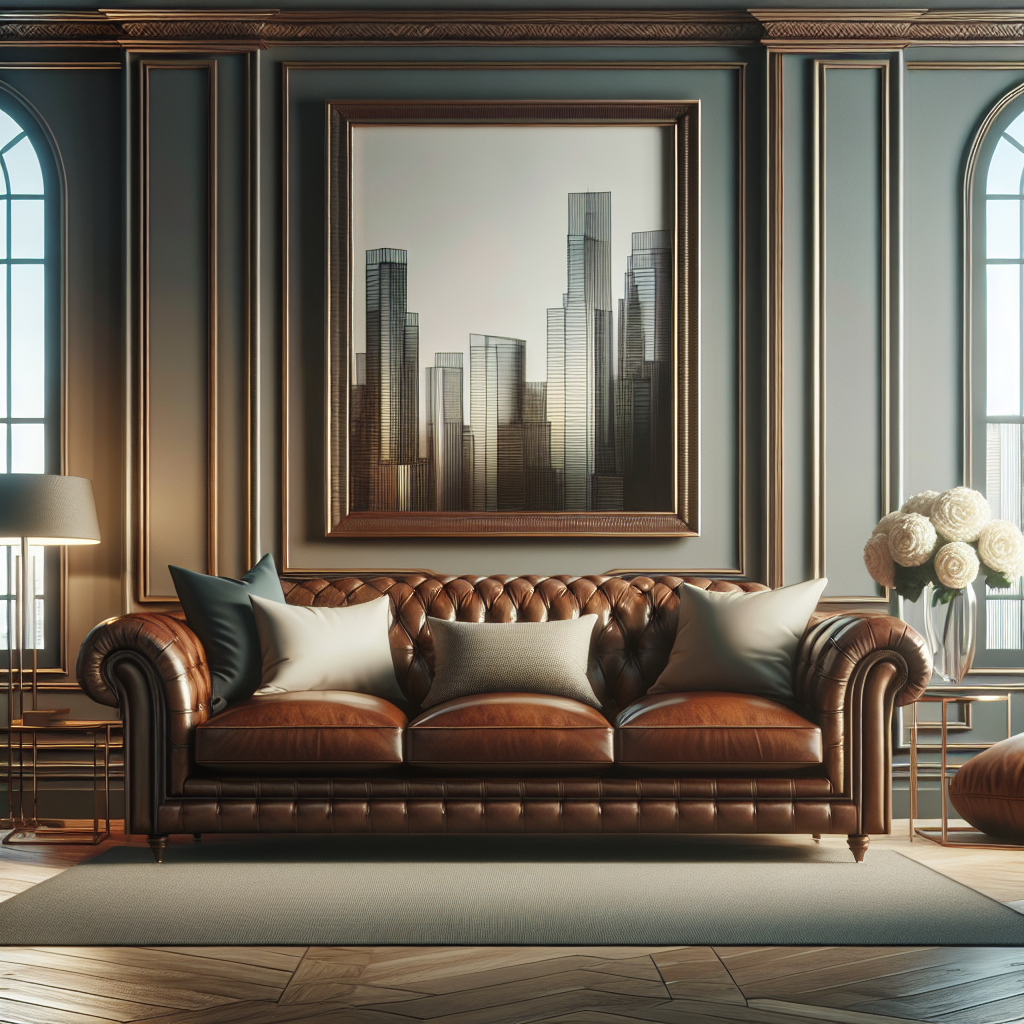If you’re on the hunt for the perfect leather sofa, then look no further. In this ultimate guide, you’ll discover everything you need to know to find the best one for your home. From the different types of leather to consider, to the key factors to look out for, we’ve got you covered. So, whether you’re a first-time buyer or a seasoned furniture enthusiast, get ready to embark on a journey that will lead you to your dream leather sofa.
Understanding Leather Sofas
Leather sofas are a luxurious and timeless addition to any living room, providing a blend of comfort, durability, and style. However, with so many options available in the market, it can be overwhelming to find the best leather sofa for your personal preferences and needs. This comprehensive guide will walk you through the various aspects to consider when choosing a leather sofa, from the different types of leather to the construction and maintenance of the furniture. By the end, you will be equipped with the knowledge to make an informed decision and find the best leather sofa that suits your taste and lifestyle.
Types of Leather
When it comes to leather sofas, there are various types of leather to choose from, each with its own characteristics and qualities. Understanding the different types of leather will help you determine the one that best fits your preferences and budget.
Durability and Quality
Durability and quality are essential factors to consider when selecting a leather sofa. Full grain leather is regarded as the highest quality and most durable type of leather. It is made from the top layer of the hide and retains the natural grain and imperfections of the leather, making each piece unique. Top grain leather, on the other hand, is slightly lower in quality but still highly durable. It is also made from the top layer of the hide but undergoes some sanding and treatment to remove surface imperfections. Split grain leather, while less durable than full grain and top grain leather, is still a good option for those on a budget. It is made from the lower layers of the hide and may have a more uniform appearance.
Comfort and Aesthetics
Apart from durability and quality, comfort and aesthetics are equally significant factors when choosing a leather sofa. The type of leather can greatly impact the overall feel and visual appeal of the furniture. Full grain leather, with its natural texture and markings, has a luxurious and rustic look. It ages beautifully and develops a patina over time, giving it a unique character. Top grain leather offers a more polished and uniform appearance, making it suitable for both traditional and modern interiors. Split grain leather, although less visually appealing, can still provide a comfortable seating experience at a more affordable price point.
Determining the Right Size and Style
Now that you have an understanding of the different types of leather, it’s time to consider the size and style of the leather sofa that will best complement your space and personal taste.
Consider your Space
Before you embark on your leather sofa hunting journey, take careful measurements of your living room to determine the maximum dimensions that the sofa can occupy. Consider factors such as the size of the room, other furniture pieces present, and the general layout. Remember to leave enough space for movement and ensure that the sofa will fit through doorways and hallways during delivery. By considering your space, you can avoid purchasing a sofa that overwhelms the room or doesn’t fit the intended area.
Choosing a Sofa Style
Leather sofas come in a wide range of styles, from traditional to modern, and everything in between. Think about the overall aesthetic you want to achieve in your living room and the existing decor. Traditional leather sofas typically feature rolled arms and button tufting, exuding a classic and elegant look. If you prefer a more contemporary feel, consider a leather sofa with clean lines, straight arms, and minimalist design. Remember that the style of the sofa should also align with your personal taste and preferences.

Deciphering Leather Grades
Understanding the different grades of leather is crucial when purchasing a leather sofa, as it determines the quality, durability, and price of the furniture.
Understanding Different Grades
Leather grades refer to the quality and processing methods used in the production of the leather. Full grain leather is the highest grade and most expensive option, as it utilizes the full thickness of the hide, showcasing the natural markings and imperfections. Top grain leather is the second-highest grade and undergoes some sanding and treatment to remove surface imperfections. Split grain leather, while lower in quality, is still a viable option for those on a budget. Bonded leather is the lowest grade and is made from leftover scraps of leather that are bonded together with adhesives.
Full Grain Leather
As mentioned earlier, full grain leather is the top-of-the-line option when it comes to leather grades. It is highly durable and showcases the natural characteristics and imperfections of the hide. Full grain leather develops a rich patina over time, giving it a unique and distinguished look. It is important to note that full grain leather requires regular maintenance and may be more susceptible to staining and scratching due to its natural finish.
Top Grain Leather
Top grain leather is slightly lower in quality than full grain leather but still offers excellent durability and aesthetics. It is sanded and treated to remove surface imperfections, resulting in a smoother and more uniform appearance. Top grain leather retains its durability and is less prone to staining and scratching compared to full grain leather, making it a popular choice for many homeowners.
Split Grain Leather
Split grain leather is a more affordable option and is made from the lower layers of the hide. It lacks the natural grains and markings found in full grain and top grain leather, resulting in a more uniform and less visually appealing appearance. While split grain leather may not be as durable as the higher grades, it can still provide a comfortable seating experience at a more budget-friendly price point.
Bonded Leather
Bonded leather is the lowest grade of leather and is made from leftover scraps of leather that are bonded together with adhesives. It is often considered an imitation leather since it contains a small percentage of real leather. Bonded leather has a plastic-like feel and is not as durable as full grain or top grain leather. It is, however, a more affordable option for those on a tight budget.
Exploring Leather Sofa Construction
Aside from the type and grade of leather, the construction of the leather sofa plays a significant role in its overall quality and longevity.
Frame and Suspension
A sturdy and well-built frame is essential for a durable leather sofa. Look for frames made from kiln-dried hardwood, as they are less likely to warp or crack over time. The joints should be reinforced with screws, dowels, or metal brackets for added stability. Additionally, pay attention to the suspension system, as it determines the level of support and comfort. Eight-way hand-tied coil springs are considered the gold standard in suspension systems, providing optimal support and durability.
Cushioning and Filling
The cushioning and filling of a leather sofa greatly impact its level of comfort and resilience. High-density foam is commonly used in modern leather sofas due to its ability to provide support and bounce back after use. Feather-filled cushions offer a plush and luxurious feel, while down-filled cushions provide a softer and more relaxed seating experience. Ultimately, choose a cushioning and filling option that aligns with your personal preference and desired level of comfort.
Stitching and Seams
The stitching and seams of a leather sofa contribute to both its aesthetics and durability. Look for sofas with double stitching or reinforced seams, as they are less likely to unravel or come apart over time. Neat and well-aligned stitches are indicative of a well-made sofa. Additionally, check for any loose threads or uneven seams when inspecting the sofa before purchase.

Considering Color and Finish Options
The color and finish of your leather sofa can significantly impact the overall look and feel of your living room. Consider the following factors when deciding on the color and finish of your leather sofa.
Neutral versus Bold Colors
Neutral colors such as black, brown, and gray are popular choices for leather sofas as they easily blend with various interior styles and color schemes. They provide a timeless and versatile option that can withstand changing trends. Bold colors, on the other hand, can add a pop of character and personality to your living room. Colors like burgundy, navy, or even vibrant shades like yellow or green can make a statement and become the centerpiece of the room. Keep in mind that bold colors may require more careful consideration in terms of long-term compatibility with your evolving style preferences.
Natural versus Pigmented Finish
Leather sofas come in two main finish options: natural and pigmented. A natural finish allows the natural characteristics and markings of the leather to show through, providing a more rustic and authentic appearance. Natural finishes also develop a rich patina over time, giving the leather a unique and aged look. Pigmented finishes, on the other hand, have a protective layer applied to the leather, providing a more uniform appearance and added durability. Select the finish that best suits your desired aesthetic and level of maintenance.
Choosing the Right Color and Finish for your Space
When choosing the color and finish of your leather sofa, consider the existing color scheme and decor of your living room. A leather sofa should complement and enhance the overall ambience of the space rather than clash with it. If you have a neutral color palette with light-colored walls and furniture, a darker leather sofa can provide a striking contrast. On the other hand, if you have vibrant or patterned walls and decor, a neutral or lighter-toned leather sofa can balance the visual elements in the room. Ultimately, choose a color and finish that you love and that reflects your personal style.
Evaluating Comfort and Support
Comfort and support are crucial factors to consider when selecting a leather sofa, as it is a piece of furniture that you will be spending a significant amount of time sitting or lounging on.
Seat Depth and Height
The seat depth and height of a leather sofa can greatly affect the overall comfort and ergonomics. Consider your personal preference and body type when determining the ideal seat depth. Some individuals prefer a deeper seat that allows them to sink in, while others prefer a more shallow seat for a more upright sitting position. The seat height should also be comfortable for both your legs and feet to rest on the ground while maintaining good posture.
Cushion Firmness
Cushion firmness is another important aspect to evaluate when testing out a leather sofa. Some people prefer a firm cushion for better support, while others prefer a softer cushion for a more plush and cozy feel. It ultimately comes down to personal preference and how you like your seating experience. However, keep in mind that cushions that are too soft may sag over time, while overly firm cushions may lack the desired comfort.
Back Support
A leather sofa should provide adequate support for your back, ensuring that you maintain good posture while sitting. Look for sofas with cushions or built-in lumbar support that properly align with the natural curve of your spine. Additionally, check the height of the backrest to ensure that it offers ample support for your shoulders and neck. A well-supported backrest will contribute to a comfortable and enjoyable seating experience.
Assessing Maintenance and Cleaning
Proper maintenance and cleaning of your leather sofa are essential to ensure its longevity and appearance. Here are some considerations when it comes to upkeep.
Cleaning and Conditioning Products
To maintain the beauty and durability of your leather sofa, it is important to use the right cleaning and conditioning products specifically formulated for leather. Avoid harsh chemicals or household cleaners that can damage the leather’s finish. Instead, opt for gentle leather cleaners and non-abrasive cleaning tools such as soft cloths or sponges. Conditioning the leather periodically can help restore moisture and prevent the leather from drying out and cracking.
Regular Maintenance Tips
Aside from using appropriate cleaning and conditioning products, there are other regular maintenance tips you can follow to keep your leather sofa looking its best. Avoid placing the sofa in direct sunlight or near heat sources, as prolonged exposure to these elements can cause the leather to fade or crack. Use coasters or placemats to protect the leather from spills, stains, and scratches. Regularly dust and vacuum your leather sofa to remove loose dirt and debris. Additionally, rotate the cushions periodically to ensure even wear and prevent excessive sagging.
Understanding Price Factors
When shopping for a leather sofa, the price can vary significantly depending on a variety of factors. Understanding these factors will help you make an informed decision and stay within your budget.
Pricing Based on Leather Type
The type of leather used greatly influences the price of the sofa. As mentioned earlier, full grain leather is the highest quality and most expensive option, while top grain and split grain leather are more affordable. Bonded leather is typically the least expensive option due to its low-quality materials.
Additional Features and Customization
Additional features and customization options can also impact the price of a leather sofa. Features such as power reclining mechanisms, adjustable headrests, or built-in cup holders add convenience and functionality but also increase the cost. Customization options such as selecting a specific leather color, finish, or sofa size can also result in a higher price tag. Consider your budget and prioritize the features and customization options that are most important to you.
Reading Reviews and Comparisons
Before finalizing your purchase, it is always beneficial to research and read reviews and comparisons of different leather sofa brands and models. This will give you insights into the experiences of other customers and help you gauge the overall quality and customer satisfaction of a particular sofa. Look for reputable websites, forums, and review platforms that provide unbiased and detailed information. By gathering information from multiple sources, you can make a more informed decision about which leather sofa is the best fit for you.
Researching Brand Reputation
When reading reviews, pay attention to the reputation and history of the brand. Established and reputable brands are more likely to provide high-quality products and reliable customer service. Look for brands that have been in the industry for a considerable amount of time and have positive customer feedback. Additionally, consider the warranty and after-sales support offered by the brand, as this can be an indication of their commitment to customer satisfaction.
Comparing Features and Customer Experiences
In addition to brand reputation, compare the features and specifications of different leather sofa models. Identify the features that are important to you and prioritize them based on your needs and preferences. Consider factors such as comfort, durability, construction, and overall value for money. Reading about the experiences of other customers who have purchased the same or similar models can provide valuable insights into the pros and cons of a particular sofa.
Exploring Warranty and Return Policies
Lastly, it is essential to understand the warranty and return policies of the leather sofa you intend to purchase. These policies can give you peace of mind and protection in case of any manufacturing defects or dissatisfaction with the product.
Understanding Warranty Coverage
A comprehensive warranty is a reflection of the manufacturer’s confidence in the quality and craftsmanship of their product. Look for sofas with warranties that cover structural components, such as the frame and suspension system, as well as the leather itself. Be aware of any limitations or exclusions stated in the warranty, such as damage caused by improper use or neglect. Understanding the warranty coverage will help you make an informed decision and have recourse if any issues arise.
Return and Exchange Policies
Even with careful research and consideration, there may be instances where the leather sofa you purchase doesn’t meet your expectations or fit your space as anticipated. Familiarize yourself with the return and exchange policies of the retailer or manufacturer before making a final decision. Check if they offer a trial period or satisfaction guarantee that allows you to return or exchange the sofa within a specific timeframe. Knowing your options for returns or exchanges will provide you with added peace of mind and flexibility in case your choice doesn’t work out.
In conclusion, finding the best leather sofa requires careful consideration of various factors such as the type of leather, construction quality, comfort, maintenance needs, and pricing. By understanding the different types of leather and grades, as well as evaluating the construction and comfort aspects, you can make an informed decision that aligns with your personal taste, lifestyle, and budget. Additionally, researching brand reputation, reading reviews, and understanding warranty and return policies will give you additional confidence in your purchase. A well-chosen leather sofa will not only enhance the aesthetic appeal of your living room but also provide comfort and durability for years to come.

